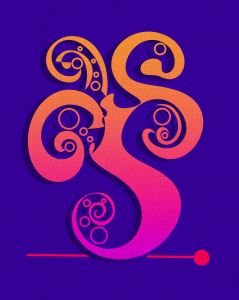11.02.2024
You can see the poster here (not shared on my blog for potential legal reasons):
https://tlevelinfo.org.uk/
The tagline of the poster is ‘One thing parents and teenagers CAN agree on’.
The Indian mother stands back to back with her daughter. The two women are looking at each other sideways, both with their arms crossed. They are both smiling. The Indian mother is dressed in traditional Punjabi clothes, with a typical Indian hairstyle. She is wearing Indian costume, Indian jewellery like the bangles. The daughter is wearing a Western hairstyle with dyed red hair. She has a nose ring instead of the nose stud like her mother which is more of a Punjabi tradition. The daughter’s fingernails are painted black, a Western colour. She is wearing Western clothes and Western jewellery.
It is obvious that that the Indian mother represents Indian tradition. When the poster designers thought of the fight between the generations, they decided to base tradition on the Indian mother. The daughter represents rebellion against the mother and Westernisation. The Indian mother is not ‘assimilated’ or ‘integrated’ to borrow the garbage vocabulary of this racist government in the UK. On the other hand, the daughter is ‘assimilated’ or ‘integrated’. She represents the future – the people that are going to do these T-Levels and get ‘educated’. This last point is important – the one that is going to be educated is the Westernised one, not the traditional one. The one that is associated with wisdom and the truth is the Westernised one. Rebellion against Indian tradition is made ‘cool’ – the teenager looks ‘chic’ and sophisticated while the Indian mother is austere.
In the poster, the following racist oppositions are made against Indian mothers and the Indian tradition, largely through implication. It is pointless to say that these oppositions are not happening – the whole poster is designed as an exercise in contrast and comparison:
1.Past/Future or Tradition/Modernity – The Indian mother is ‘backwards’ looking. This is represented by the fact that she is ‘behind’ the Westernised teenager. The daughter looks backwards at her mother only to go forwards and to differ from the Indian mother. She is associated with the new qualifications in the form of the T-Levels and the new.
2.Non-Integration (non-assimilation)/Integration (assimilation) – In the Tube poster that I saw (which you cannot see on the webpage I have provided below), they cut out the Indian mother’s elbow in the poster. In other words, what is being marginalised in the Tube poster is the Indian mother. Both bodies are not equal in size and stature – the daughter is made to have the greater stature and dominate the frame (actually, you can see from the photograph that the mother’s body is more dominant in stature – it has deliberately been made to look inferior). The mother appears as a sheer vertical, the daughter has a more interesting triangular pose which draws more attention. Why? Now we are in the realm of speculation. It is probably because she is not seen as integrated into Western culture because she is different. So they cut out her Indian suit and her different form of fashion, vision and style.
3.Age/Beauty and Youth – The younger daughter appears more beautiful, so the viewer is made to associate Westernisation of womanhood with beauty and greater attraction.
4.Clothes/The Body – The teenager shows off more of her body with the bare arms. This could be associated with many things, but the one that seems to appear to be relevant to this poster is the idea of honesty and openness, since the T-Levels are associated with wisdom and truth. The Indian mother is completely covered up, so the contrast is apparent – she is associated with a lack of wisdom.
The Mirroring
The two women mirror each other in their postures. This is crucial to the message of the poster – even the Indian woman who is not assimilated in this culture can agree that T-Levels are a good idea – even someone blinded by ‘tradition’. This is the greatest trick of the West – the idea that its education – which is the reason that the two women are separated in the first place – is the superior form of education, the best way to go. That the education is somehow objective and not targeted at eliminating difference and Indian identity in this world through its arrogant Eurocentrism and prejudice of any different way of thinking or doing things.

One thought on “How Westerners See Indian Tradition and Indian Mothers: Analysis of the T-Levels Tube Poster”